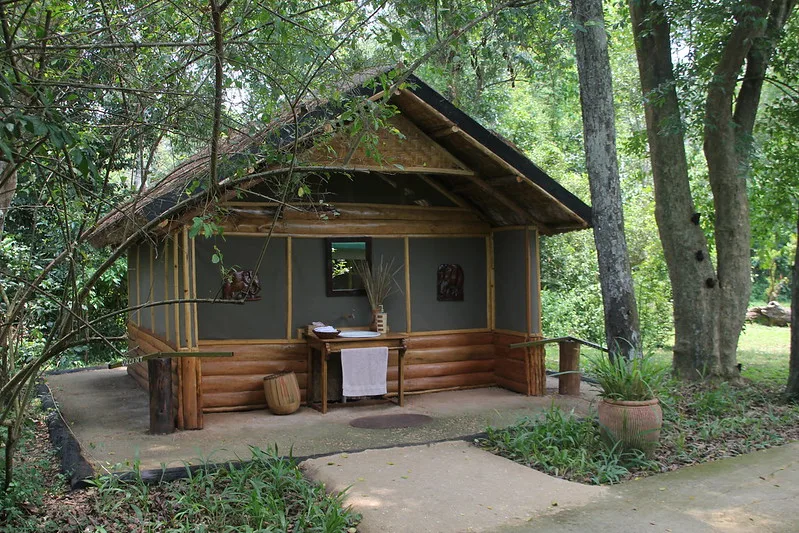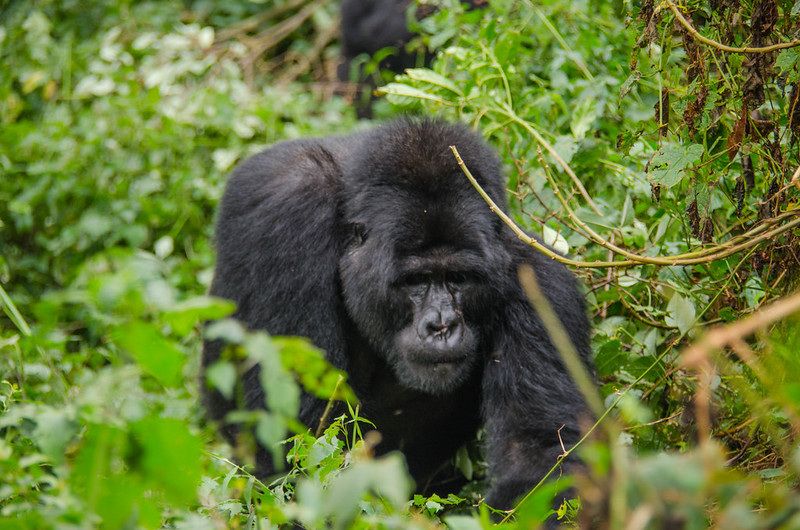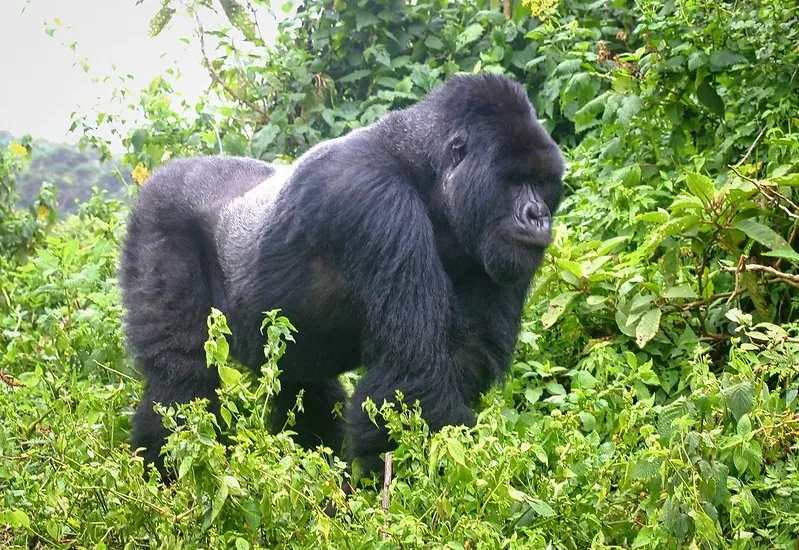Vous êtes bienvenus, aventuriers courageux, dans les merveilles sauvages de l'Ouganda, où l'appel de la…
Hiking the Rwenzori Mountains
Hiking the Rwenzori Mountains, The Moon Mountains are the third highest peak in mythical Africa!! They are located on the spine between Uganda and the Democratic Republic of the Congo and have a compellingly stunning panorama that is accented by colorful flora and dazzling glaciers. The terrain in the region quickly transitions from heavy bamboo, heather zone to afro alpine, which is visibly gorgeous. Only by venturing into these 5109m towering cloud mountains is it possible to determine the link between slope and altitude, which is magnificent. The 3,975m Mutinda viewpoint, a monolith of granite that rises over the valley, is reached by whizzing up the mountain. Come see the creatures, the screeching 217 bird species, and the high-altitude exhilaration! If nature, silence, and adventure are the only luxury remaining in the world today, the Rwenzori highlands hiking safari provides all of them.
Trekking facts about the Rwenzori Mountains.
![]() There is a snow-capped majesty in Africa that redefines the term amazing.!! Africa’s third tallest peak, known variously as the Moon Mountains, the Cloud Mountains, and the Rwenzori, is located mostly in western Uganda. The Rwenzori Mountains are located inside the Rwenzori Mountains National Park, which is an important bird habitat and a RAMSAR site. A Rwenzori mountains hiking safari is the most convenient way to traverse the mountain.
There is a snow-capped majesty in Africa that redefines the term amazing.!! Africa’s third tallest peak, known variously as the Moon Mountains, the Cloud Mountains, and the Rwenzori, is located mostly in western Uganda. The Rwenzori Mountains are located inside the Rwenzori Mountains National Park, which is an important bird habitat and a RAMSAR site. A Rwenzori mountains hiking safari is the most convenient way to traverse the mountain.
The Rwenzori mountain range is located inside the Albertine rift and is home to over 217 bird species, including 17 endemics. This is without a doubt a minefield of discovery, drawing people into its magnificent and dazzling glaciers. The magnificent feature soars 5109 meters above the earth’s surface, reaching inconceivable heights above the clouds. Rwenzori has been classified as a block mountain rather than a volcanic mountain, which has inspired people to visit and see for themselves.
How the mountains obtained their various names.
The Rwenzori Mountains border the Democratic Republic of the Congo, a land rich in both nature and riches. The region is traversed by the Nile, another sight that derives some of its water from glacial runoff. This tallest structure in Uganda has multiple peaks that provide breathtaking vistas, which verifies the findings of Alexander Ptolemy, an explorer who gave this distinctive feature its most renowned moniker, Mountains of the Moon. The word “cloud mountains” was invented afterwards by Henry Morton Stanley, who was under the grip of extreme impression at the time. The park contains glaciers, snowfields, and waterfalls and has been represented as one of the most beautiful Alpine locations in the world. On May 24, 1888, European explorer Henry Stanley charted the Rwenzori Mountains. As a result, one of the peaks was named after him. He named the main feature ‘Ruwenzori,’ a native term that means “Rain-Maker” or “Cloud-King” in Swahili.
Facts on biodiversity in the Rwenzori Mountains
![]() The iconic range, which runs through both nations, not only displays the coexistence of rock and snow, but also serves as a playground for many of the creatures that call it home. Uganda, being a country rich in bird life and other endemics, leaves the ranges as no exception; the Rwenzori Park is home to 217 species of birds, 17 of which have a naturally formed restriction of only being found in the Rwenzoris, which supports UNESCO calling it a priority Birding Area. At about 1800 meters, the Handsome Francolin, Rwenzori Turaco, Long-eared Owl, Barred Long-tailed Cuckoo, Cinnamon-chested Bee-eater, Strange Weaver, Archers’ Robin-chat, Rwenzori Batis, White-starred Robin, Montane Sooty Boubou, Slender-billed Starling, Lagden’s Bush Shrike, Blue-headed Sunbird, Barbets, Allow it to sink in.
The iconic range, which runs through both nations, not only displays the coexistence of rock and snow, but also serves as a playground for many of the creatures that call it home. Uganda, being a country rich in bird life and other endemics, leaves the ranges as no exception; the Rwenzori Park is home to 217 species of birds, 17 of which have a naturally formed restriction of only being found in the Rwenzoris, which supports UNESCO calling it a priority Birding Area. At about 1800 meters, the Handsome Francolin, Rwenzori Turaco, Long-eared Owl, Barred Long-tailed Cuckoo, Cinnamon-chested Bee-eater, Strange Weaver, Archers’ Robin-chat, Rwenzori Batis, White-starred Robin, Montane Sooty Boubou, Slender-billed Starling, Lagden’s Bush Shrike, Blue-headed Sunbird, Barbets, Allow it to sink in.
The Rwenzori mountain range is 120 kilometers long and 65 kilometers broad, and it is home to 70 animal species as well as some of the world’s rarest plants. Six Albertine Rift endemics, elephants, chimps, Rwenzori otters, and leopards are among the animals. The game also includes primates such as the colobus (Angola and black-and-white kinds) and blue monkeys. Small antelopes like bushbucks and odd reptiles like the three-horned chameleon are examples.
Activities carried out on the trekking safari in the Rwenzori Mountains.
Hiking the Rwenzori Mountains
This occurs inside the range to the glacier on the highest summits. Day treks in the thick tropical jungle at the foothills can also be combined with unusual activities such as hand-fishing in streams that are claimed to be similar to the Torentine river in Game of Thrones. During the trek, one may see the turaco, a multi-colored bird, as well as the famous three-horned chameleon, which survives due to the abundance of insects!! Up the slope, meandering rivers keep revealing themselves, providing a spectacular perspective of the aura that makes one wonder where the hell everyone else is.
Ms Beryl Park, 78, was the oldest known person to ascend Margherita Peak in 2010, which rewards many with both amazement and heroism. Landscapes, colors, and creatures change with each hour and altitude climb, exactly like information from a fairy tale. The range is endowed with tropical snow peaks, including Africa’s third highest point, with the lower slopes covered in moorland, bamboo, and rich, wet montane forest. Giant lobelias and “everlasting flowers” are stretched across the slope with huge tree-heathers and multicolored mosses, creating a beautiful and spectacular view. These lobelias, together with Senecio (groundsel), are representative of the Afro-alpine altitudinal vegetation zone, which is one of the world’s rarest plant communities, found only in East African highlands over 3800m.
According to statistics, only a few thousand of the 15,000 travelers from all over the globe who have climbed the Rwenzori mountains have reached the Margherita Peak. This is due to the difficulty of the walk up the mountain, which provides a grueling experience for every explorer who joins up for the challenge. Due to the heavy rains that frequently lash the area, inclement weather might always strike throughout the walk. As a result, many people walk through in a torchlight procession to the summit, so bring gumboots, thick garments, and plenty of drinking water. Breaks are generally required since the environment has changed. The ride along the vertiginous ridgeline, however, may always be continued with the persistence of a laboring 1900 automobile engine as one looks forward to the summit day with the presence of guides, a selection of ropes, pulleys, and ladders. Once at the summit, one reflects on the trek and compares it to a walk in the park, causing him or her to explode into high altitude bliss.
Cultural interaction
You’ll have lots of chances to see the inhabitants near the foothills of the Mountain of the Moon practicing their traditional lifestyles and hobbies, such as cultural dances, and if you’re lucky, you could even receive some drumming and dancing lessons. You will also get the opportunity to visit the Ruboni hamlet, where you will learn about the ancient lives of the forebears of the moon highlands.


